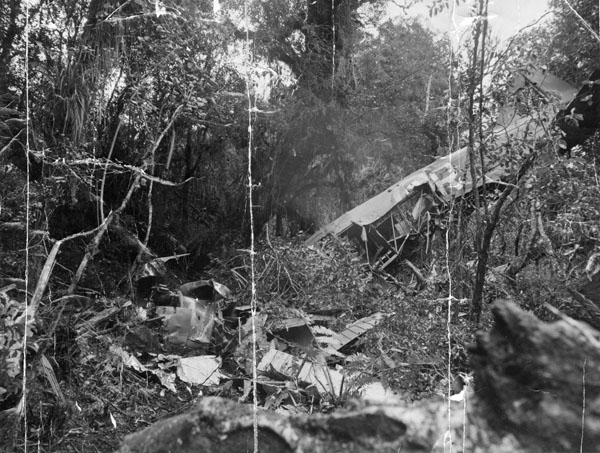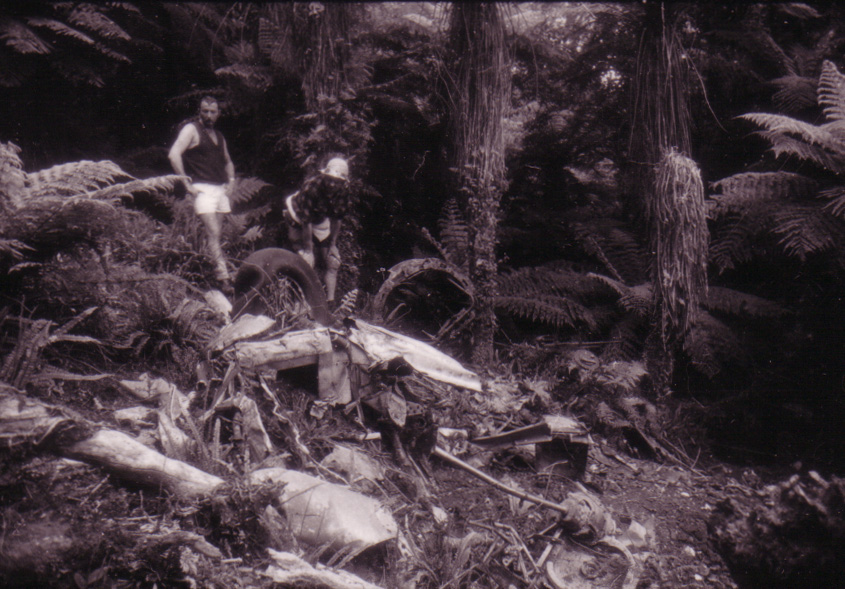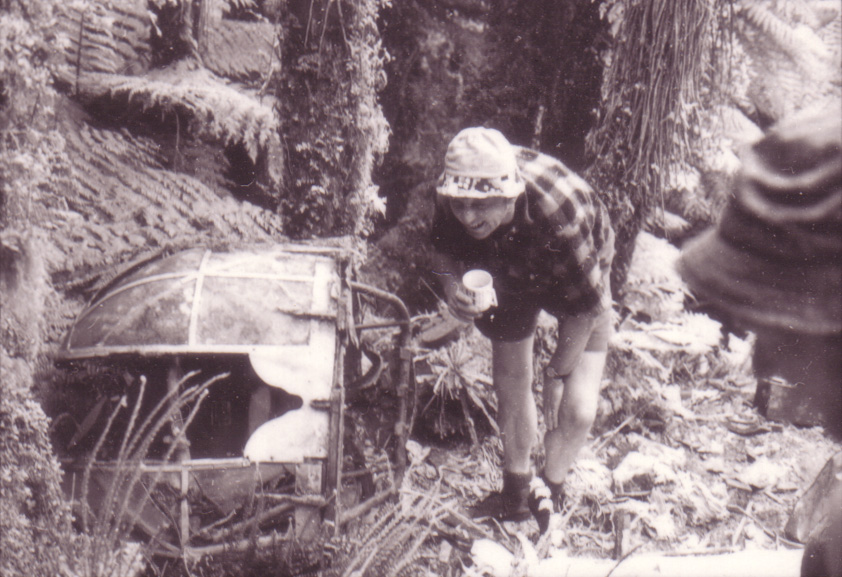





It was a perfect spring day when New Plymouth pilot Stanley Green and photographer James Austin took to the air in a Gypsy Moth plane to take photographs of Mount Taranaki. Green (an electrician) was an experienced pilot, a member of the New Plymouth Aero Club and a flying officer in the No. 2 Bombing Squadron of the Territorial Reserve for the Royal New Zealand Air Force (RNZAF). Austin was a tobacconist and photographic dealer who owned a shop on central Devon Street in New Plymouth. The two had flown together several times on aerial photographic flights. This was their second flight testing a camera fitted with new infrared plates.
Later that afternoon George Burrows and his father (possum trappers from Kaimiro) saw the plane flying over the Pouakai Range toward New Plymouth at a height of about 5000 feet. "It was losing height and its engine started to splutter and finally, after catching again, died away. The plane went into a long dive which ended in a crash", George told the Taranaki Herald at the time.
The elder trapper went in search of the plane while George went to Kaimiro to telephone for help. A large search party of over 60 men (including several senior students from the Boys' High School) split up and set out. The teams battled through dense bush and scrub toward the area where the trappers had seen the aircraft go down.
The next morning the wreck was discovered on a spur of the Pouakai Range, bordering the Kaiauai Stream. Both occupants had been killed. The plane was found with its throttles wide open. It was concluded that the pilot had fainted or lost his horizon. This was the first aircraft on Mount Taranaki.
Despite being badly injured, Flight Sergeant Alexander Peterson pulled himself out of his plane's wreckage and crawled seven miles down the Oaonui Stream to get help for his injured colleague. His Avro Anson trainer had crashed into the side of the mountain, near the site of today's Oaonui Hut. Alexander reached a farmhouse on Ihaia Road and a search party was sent up the mountain. The ground party could not find the plane but next morning an air search found it, dropping a smoke bomb to alert the ground team.
Sergeant Bruce Rough had spent the night in the wrecked plane, wrapping himself in parachutes to keep warm. The airman had a fractured wrist and was suffering shock. The other crew, Flight Sergeant John Paterson Cummins and Sergeant Maurice Roy Haycock had been killed.
Just 150 metres was the difference between life and death for five men on a training run in a Ventura Bomber a month later. The bomber was on a navigational training flight from Ōhakea when it crashed on Mount Taranaki, above Ihaia Road.
The plane had hit the mountain in level flight and burst into flames on impact, killing the five men on board. They were Flight Officer Jack Martin, Sergeant Harold Day, Sergeant James McKay, Sergeant Frank Webb and Sergeant Arnold Hill. If it had been 150 metres higher, the plane would have cleared the mountain and flown free.
Errol Clince's diary for Tuesday 15 January 1974 reads: “Hunted Mangorei Stream got 10 goats found old bomber below Mangorei hut somewhere. There were a lot of empty 303 bullet shells. There was a machine gun there and an old parachute still not undone it was very rotten. I also found the leg bone of a human. I then buggered off from there fast!”
The 20 year old Forest Service hunter had been shooting goats in the area for a week and was unaware an Airspeed Oxford trainer had gone missing on Alamein Day 32 years earlier. He vividly recalls the day he came across the plane in 1974: "I was walking along up this creek just mucking around", he said. "There was a water fall and I came back from it, went left a bit and up a bank and saw the turret with the machine gun in it. I couldn't make out any of the fuselage, I think there was a bit of a wing up in a tree. It had ploughed into a tree which had fallen over it and it was covered in ferns."
Pure luck had brought the forest worker to the aeroplane's gravesite. "I mucked about with it and pulled the machine gun out. I was going to take it home because it looked the part - the first Rambo. I was most fascinated with the sights, everything was intact although it was pretty rusty." He changed his mind and left the gun beside the plane - where it later bamboozled air accident inspectors - as it should have been in the plane.
Looking back Errol says he's ashamed he didn't show more respect to the aircraft and its crew. "The worst thing about it was I ruined a lot of it because I didn't know it hadn't been found. I was a bit like a magpie. Anything there that was shiny I touched. I pulled out a parachute and opened it up. I found the controls and started playing with them."
With a wry grin he recalls the Air Force accident inspector Wing Commander Chippendale later looking at the same controls. "He was saying 'Well they're in this position so the pilot must have been doing that...' I had to look away... I'd put them wrong." He then found a shiny white object and pulled it out for a better look. "It was obvious it was a human leg bone. I put it down very quickly!"
Errol later took Taranaki Search and Rescue representative Dave Rawson up to see the plane, followed by the police, RNZAF personnel, search and rescue crew and the media. He featured in the newspaper and was a minor celebrity for a while.
The plane was identified as an Oxford that had been on a training run from New Plymouth on 23 October 1942, shooting at a towed aerial target over the sea when it got lost in heavy cloud. Aerial and ground teams had searched for the plane for three months before giving up.
Errol helped collect the remains of the airmen, Pilot Officer Rodney Dandy and crew Sergeant Douglas Martyn, Sergeant Graham Martin and Sergeant Edward Dodson who were identified from their position in the wreckage, and by initials on rings, silver plated propelling pencils and other personal belongings. "I remember we put them in sacks and carried them out", Errol said of the recovery. The recovery allowed the men's families to hold funerals and say goodbye to their loved ones. "One of the men's wives came to see me a few months later to say thank-you."
Errol worked for the Forest Service for 16 years, getting to know the mountain as well as his own backyard. Over the years he came across the sites of the other plane crashes on the mountain - the Gypsy Moth, the Avro Anson and the Ventura Bomber. He hasn't been back to the site of the Oxford crash for 25 years, but it's a find he'll never forget.
Rawson, D. (1979). "Search!”: the story of the development of search and rescue in Taranaki. New Plymouth, Masterprint.
Search the Puke Ariki Heritage Collection
LinkPlease do not reproduce these images without permission from Puke Ariki.
Contact us for more information or you can order images online here.